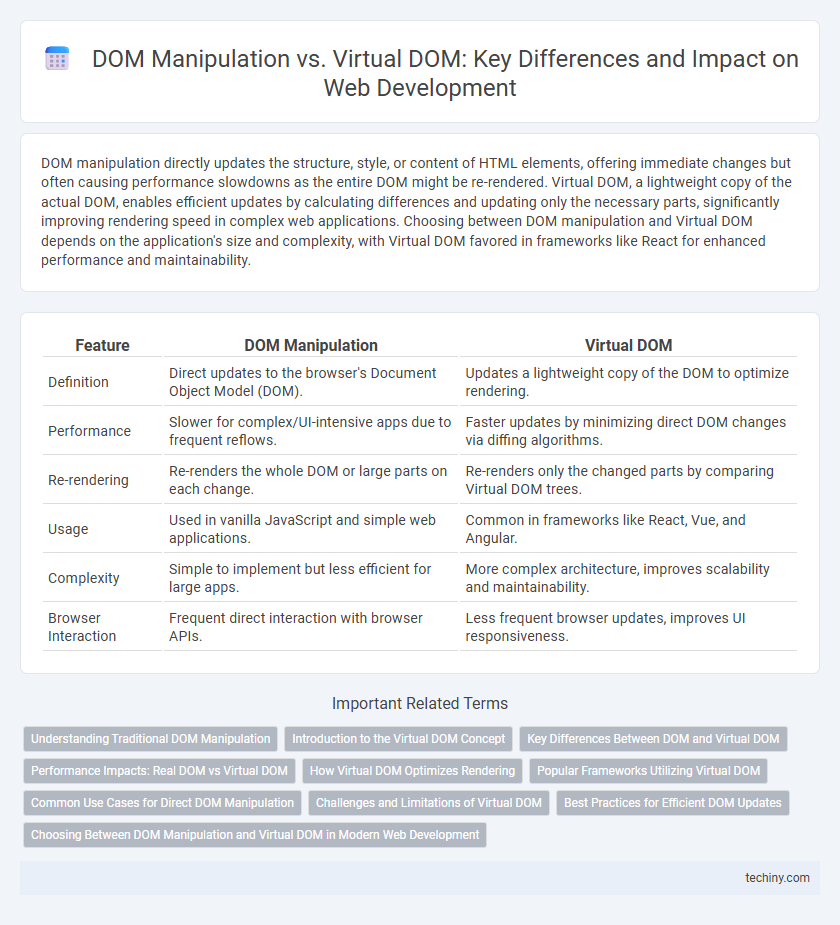DOM manipulation directly updates the structure, style, or content of HTML elements, offering immediate changes but often causing performance slowdowns as the entire DOM might be re-rendered. Virtual DOM, a lightweight copy of the actual DOM, enables efficient updates by calculating differences and updating only the necessary parts, significantly improving rendering speed in complex web applications. Choosing between DOM manipulation and Virtual DOM depends on the application's size and complexity, with Virtual DOM favored in frameworks like React for enhanced performance and maintainability.
Table of Comparison
| Feature | DOM Manipulation | Virtual DOM |
|---|---|---|
| Definition | Direct updates to the browser's Document Object Model (DOM). | Updates a lightweight copy of the DOM to optimize rendering. |
| Performance | Slower for complex/UI-intensive apps due to frequent reflows. | Faster updates by minimizing direct DOM changes via diffing algorithms. |
| Re-rendering | Re-renders the whole DOM or large parts on each change. | Re-renders only the changed parts by comparing Virtual DOM trees. |
| Usage | Used in vanilla JavaScript and simple web applications. | Common in frameworks like React, Vue, and Angular. |
| Complexity | Simple to implement but less efficient for large apps. | More complex architecture, improves scalability and maintainability. |
| Browser Interaction | Frequent direct interaction with browser APIs. | Less frequent browser updates, improves UI responsiveness. |
Understanding Traditional DOM Manipulation
Traditional DOM manipulation involves directly accessing and modifying HTML elements through methods like getElementById or querySelector, which can lead to performance bottlenecks due to frequent reflows and repaints. Each DOM update can cause the browser to recompute layouts and render changes, resulting in slower performance for complex or dynamic web applications. Understanding this process is crucial for developers aiming to optimize web performance by minimizing direct DOM interactions and using more efficient alternatives such as the Virtual DOM.
Introduction to the Virtual DOM Concept
The Virtual DOM is a lightweight, in-memory representation of the real DOM that enables efficient updates by minimizing direct manipulation of the browser's DOM. It acts as a diffing algorithm that compares the current state of the UI with the previous state, applying only the necessary changes to the real DOM, resulting in faster rendering and improved performance. Frameworks like React utilize the Virtual DOM to enhance scalability and responsiveness in complex web applications.
Key Differences Between DOM and Virtual DOM
The Document Object Model (DOM) directly represents the webpage structure, causing performance bottlenecks during frequent updates as each change leads to immediate browser re-rendering. The Virtual DOM creates a lightweight, in-memory tree that allows efficient diffing and batching of changes before updating the real DOM, minimizing reflows and improving rendering speed. This key difference makes the Virtual DOM especially beneficial for dynamic applications requiring rapid, responsive UI updates.
Performance Impacts: Real DOM vs Virtual DOM
Real DOM manipulation triggers direct updates to the browser's rendering engine, causing slower performance due to reflows and repaints with each change. Virtual DOM optimizes this process by batching updates and minimizing actual DOM operations, leading to faster rendering and improved application responsiveness. Frameworks like React leverage Virtual DOM to efficiently update only the necessary components, significantly enhancing performance compared to traditional Real DOM methods.
How Virtual DOM Optimizes Rendering
Virtual DOM enhances rendering performance by minimizing direct interactions with the actual DOM, which are typically slow and resource-intensive. It works by creating an in-memory representation of the UI, then efficiently calculating the minimal set of changes required through a diffing algorithm before updating the real DOM. This approach reduces unnecessary reflows and repaints, resulting in faster UI updates and improved overall application responsiveness.
Popular Frameworks Utilizing Virtual DOM
React, Vue, and Preact are popular frameworks that utilize the Virtual DOM to optimize web application performance by minimizing direct DOM manipulation. These frameworks efficiently update only the necessary components by comparing changes in a lightweight Virtual DOM representation, reducing costly real DOM operations. Developers benefit from faster rendering times and smoother user experiences, especially in complex or dynamic interfaces.
Common Use Cases for Direct DOM Manipulation
Direct DOM manipulation is commonly used in scenarios requiring immediate visual feedback, such as form validation, interactive animations, and dynamic content updates triggered by user actions. It excels in simple web applications or when working with legacy codebases where the overhead of a virtual DOM is unnecessary. Developers leverage direct DOM methods like `getElementById` or `querySelector` for precise control over element styles and attributes in real-time.
Challenges and Limitations of Virtual DOM
Virtual DOM optimization can improve UI rendering but faces challenges such as increased memory consumption and computational overhead due to frequent diffing and reconciliation processes. Handling complex UI states may lead to performance bottlenecks, especially in large-scale applications with deep component trees. Limitations include potential delays in updating the actual DOM and difficulties in debugging asynchronous rendering behaviors.
Best Practices for Efficient DOM Updates
Efficient DOM updates rely on minimizing direct manipulation by leveraging the Virtual DOM, which batches changes and reduces costly reflows and repaints. Best practices include using libraries like React that diff the Virtual DOM to apply only necessary updates, improving performance and user experience. Avoiding frequent manual DOM access and instead utilizing declarative rendering patterns ensures smoother and faster UI interactions.
Choosing Between DOM Manipulation and Virtual DOM in Modern Web Development
Choosing between DOM Manipulation and Virtual DOM in modern web development depends on application complexity and performance needs. Direct DOM manipulation offers fine-grained control but can lead to slow rendering with frequent updates, while Virtual DOM improves performance by minimizing actual DOM changes through efficient diffing and batching. For dynamic, large-scale applications requiring seamless user experiences, Virtual DOM frameworks like React provide optimized rendering, whereas simpler projects may benefit from straightforward DOM manipulation techniques.
DOM Manipulation vs Virtual DOM Infographic

 techiny.com
techiny.com